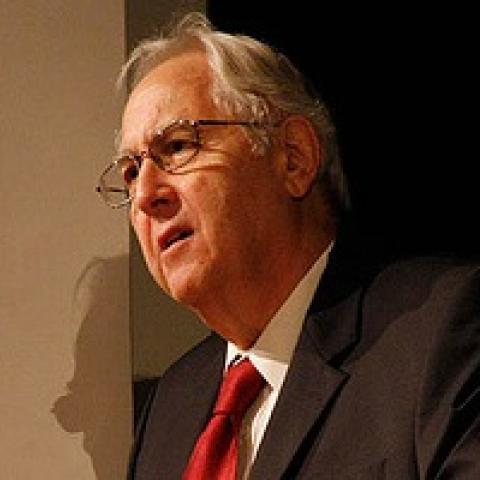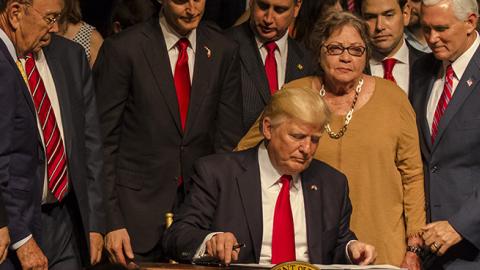My wife and I recently returned from a trip to Cuba -- which we wrote about in the new issue of The Weekly Standard -- just in time to hear Donald Trump announce his new Cuba policy in Miami. His speech to the most ardent anti-Castro Cuba-Americans was strong and enthusiastically received. He promised to reverse Obama’s 2014 opening, which had not led to reforms in human rights, to political freedom, or to the lessening of repression.
In truth, Trump’s Cuba policy is not a reversal. It maintains almost all of the major features of the Obama policy: commercial flights and cruise ship trips to Cuba will continue; cash remittances can be sent regularly by Cuban-Americans to their families; Cuba will remain off the list of state sponsors of terror; areas of cooperation in medicine, sciences, and counter-terrorism will continue; and full diplomatic relations will remain, with official embassies in both Cuba and the United States.
One area that will be impacted is American tourism to the island.
Since the Soviet Union and Venezuela ended their subsidies to Cuba, which for decades had shored up the country’s failing economy, the Cuban government increasingly has turned to tourism to fill the shortfall. Trump wants to deprive the regime of profiting from this growing sector, especially when more and more Americans are headed there and now make up the second largest group of visitors behind Canadians.
From now on, Americans will be barred from doing business with hotels under majority control of a management company run by the military -- called GAESA -- that controls most of Cuba’s tourist industry. This includes staying in their rooms, eating at their restaurants, or attending shows, as well as eating in state-run restaurants.
The idea, as Marco Rubio stated, is to encourage American travelers to Cuba:
... to spend their money primarily with individual Cubans who own private businesses ... to empower individual Cubans to be economically independent of the Castro regime.
Now, travelers must stay in either an Airbnb or privately owned apartments (particulares), and must eat in privately owned restaurants (paladars). Many Cubans are finding opportunities in establishing these and other tourist-related businesses: i.e., taxi drivers, private tour guides, etc.
According to the American embargo, which only Congress can change, only people who are licensed to travel to Cuba can travel there -- but this does not include individual tourist travel. Obama loosened these restrictions, allowing Americans to travel both independently and as part of a group if they were on a legally registered people-to-people (P2P) trip. These trips required travelers to fall into 12 categories of authorized travel. They are intended to ensure meaningful interactions between American travelers and Cubans through a variety of cultural and educational exchange activities.
Under Obama, people-to-people travel was loosely enforced and self-reported. But now, people-to-people travel will be banned for individuals not on a Treasury-licensed tour (although the consequences of violating these regulations remain unclear). In effect, if one now wants to travel to Cuba, he or she must go on an officially licensed and approved tour that does not allow for individual exploration of the country, and keep to an approved and scheduled itinerary.
Writing in the Washington Post, journalist Nick Miroff notes:
[T]he new rules will herd Americans back toward the kind of prepackaged, predictable group tourism that the Cuban government actually prefers -- and earns more revenue from.
One visiting American told Miroff:
[I]f you come here on a package tour, you see what the Cuban government wants you to see.
When you look over some of the licensed tours, that certainly seems to be the case.
Ads for these tours show just how much they become -- even if the tour company does not want this to happen -- Potemkin Village tours, much to Raul Castro’s liking. They will certainly exclude talking to dissidents who challenge the Castro regime, or to any Cuban who experiences the hardships that Cubans live with every day -- from dilapidated and crowded housing to procuring sufficient food.
If you doubt this, you should read dissident blogger Yoani Sanchez’s book, Havana Real: One Woman’s Fight to tell the Truth about Cuba Today. In a diary, she lets readers know what it is like to struggle in a society controlled by a propaganda machine which does everything but tell its own citizens the truth. It should be on the reading list of every tour going to Cuba; as you may suspect, it isn’t on any of them.
Cruise ships which run their own officially approved tours include ones like the Norwegian Cruise Line offers: __The Legendary Tropicana Cabaret; Ultimate Highlights of Havana; Cuban Rum and Cigars; The Art of Cuba Yesterday, Today and Tomorrow__. Intrepid Travel advertises that, on their Hola Cuba tour, you’ll get your meals included, travel by minibus, and stay in local guesthouses. For nine days, you’ll encounter the faded buildings of Havana, visit tobacco farms in beautiful Viñales, stroll the European boulevards of Cienfuegos, and salsa dance in charming Trinidad, all while learning the history and culture from an expert local guide.
Even academic tours like the one sponsored by History News Network, a serious, unbiased website that most historians know of and visit, will be affected. HNN has a tour coming up in mid-December that should be embarrassing to the site’s long-established impartiality. First, it assures its readers
[The] planned December trip to Cuba is going ahead as planned. Our guide is licensed by the United States government to run educational tours to Cuba that comply with the new rules imposed by the Trump administration.
And they warn would-be independent travelers:
See Cuba the only way you can now -- with a licensed guide.
The tour is led by a sociologist who is an expert on Cuban culture, Charles Bittner. But the tour is accompanied as well by a graduate and professor of foreign languages at the University of Havana, “a lifelong Cuban.” If you read sites about the extent of political repression in Cuba, you will find ample examples of many professors at the same university, as well as teachers throughout Cuba, who have lost their university jobs because of a position or analysis that challenges the official line of the Cuban Communist Party and the Castro regime. Indeed, my wife and I interviewed one such journalist and professor who has not worked for a long time since he spoke against government policy and was immediately fired.
The HNN tour itinerary combines regular tourist attractions that give a rosy picture of Cuban life, including the art and music that Cubans deserve to be celebrated for, and notes that they will eat their meals at paladares. They will have a “socio-economic discussion” with an urban planner, who will talk about “housing, infrastructure, investment and restoration programs in the city” of Havana. He will help to “contextualize” Old Havana, and “leave you with a better understanding of why Havana looks the way it does today.”
I’ll bet those on the tour will learn it isn’t the government’s fault Cubans live in decaying buildings.
Finally, they will attend the archetypal propaganda site in Havana: “The Museum of the Revolution.” It glorifies the policies of Fidel Castro and Che Guevara, and is a propaganda display for gullible tourists and a mandatory trip for students in lower and high schools. There you will find the actual Granma, the ship that Fidel and his guerrillas sailed to Cuba before storming the Moncada barracks. You will find the Russian tank Fidel rode on during the Bay of Pigs fighting.
Does the museum depict how Che Guevara ordered the mass shooting without trial of those he termed “Bataistianos,” and how he took glory in shedding the blood of political enemies of the Revolution? I hope Prof. Bittner asks the guide why this is omitted from the history of the Revolution’s early years.
They also meet with Rafael M. Hernandez, chief editor of Temas, an approved Cuban magazine in the social sciences. Finally, the very last event before they leave is a “morning discussion” with Carlos Alzugaray Treto about U.S.-Cuba relations. As his Wikipedia entry shows, he filled scores of major government posts during the heyday of Fidel Castro’s oppressive regime. What country do you think this former apparatchik will tell his audiences is responsible for the years of discord between both nations?
I’ll give HNN the benefit of the doubt that they do not mean to run a propagandistic program. Hopefully, when they visit the home of a Cuban family “which will focus on the daily lives of regular Cubans,” they will see what state communism has done to the Cuban people. But will the family chosen be one that tells its audience about how the revolution’s great progress has helped them?
The most egregious tour, however, is an approved tour put together by The Nation magazine.
Check out its latest online ad “Santiago to Havana: Trail of the Revolution.” As the text makes clear, this is a propaganda tour which follows “the trail of the Cuban Revolution on an exciting journey,” where you will “learn about the Revolution from experts at some of its most pivotal locations,” including a visit to the “Moncada Barracks in Santiago de Cuba, where the first armed assault of the Cuban Revolution took place.” You will tour the “Che Guevara Mausoleum in Santa Clara,” and “engage in a discussion with former Cuban diplomat and expert on U.S.-Cuba relations, Carlos Alzugaray Treto.”
Treto is the very same individual chosen by HNN to lead its similar discussion on foreign policy. Does the organization think that Mr. Alzugaray will give them anything differing from Raul Castro’s official line?
To top it off, you will “attend a discussion with a local historian from the Committees for the Defense of the Revolution.” This, perhaps, is the giveaway. The CDR is the regime’s spy apparatus on the local level, meant to give every apartment building one person who sees to it that everyone goes when a demonstration is called, that there are no complaints about hardships, and that every resident listens to the government and defends all of its policies. Those who excel get rewards such as being put at the top of the list to receive new TVs or refrigerators when they arrive; those who don’t are deprived of necessary ration cards and are meant to suffer for their refusal to toe the line.
When one goes on The Nation tour, one will receive the most pro-regime tour that an individual can take.
As I conclude, I just received an email from The Nation. It states the following:
As you know by now, President Trump has imposed new restrictions on our constitutional right to travel to Cuba. These changes DO NOT affect the Nation trips to the island; ironically, tours like ours are now the only way the inquisitive, conscientious traveler can conduct a “people-to-people” visit to Cuba.
This is an official licensed and approved tour. Yet its participants stay in a military-owned hotel, the famous Capri, which unless I’m wrong, is no longer owned by the mafia and the actor George Raft. Somehow, The Nation has been rewarded by allowing its group to ignore the ban on staying in military-owned accommodations.
As the magazine stresses, you can no longer go to Cuba on your own. If you were still allowed, perhaps you would learn more about the country than on an orchestrated tour. Now you have no choice but to choose the tour. I don’t think this is what Marco Rubio had in mind when he developed the new regulations for Donald Trump.















